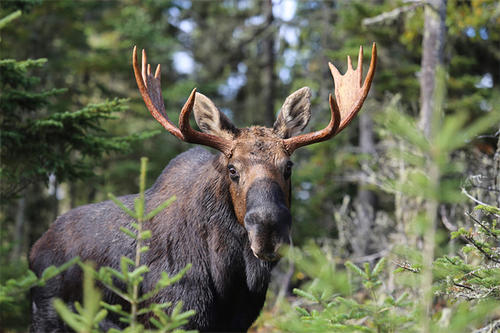Researchers take a new approach to understanding a major source of Minnesota moose decline

New research from a multi-disciplinary team shows where a moose spends time in the spring has the strongest connection to whether the moose becomes infected with the parasite known as brain worm.
Published in the Journal of Mammalogy, this is one of the first studies aimed at understanding the environmental factors and the times of year moose are most susceptible to brain worm infection.
Understanding the risks of brain worm to moose is important because the population has experienced a large decline in recent decades. Researchers estimate approximately 25% to 45% of Minnesota moose have become ill or died due to brain worm.
Brain worm larvae are spread through deer fecal matter, before being ingested by slugs and snails that are, in turn, eaten by moose when eating plants. While most research has been focused on looking for the parasite inside slugs, snails and deer feces, the research team — which included researchers from the University of Minnesota Twin Cities, Minnesota Department of Natural Resources (DNR), Minnesota Zoo and the University of Minnesota Duluth — tracked moose previously collared by the DNR and conducted necropsies on the moose at the time of death.
If a moose was infected, researchers used GPS locations to trace where the moose had been. They then examined the relationship between the moose’s locations and conditions that might influence the probability of becoming infected, including deer density, areas where deer spend more time and environmental conditions to which the moose was exposed.
Researchers discovered that:
- where moose spent time during the spring had the strongest connection to whether they became infected with brain worm;
- the strongest relationship found was that moose that spent more time in conifer forests during the spring had the lowest risk of brain worm infection, and;
- deer density and habitat use did not appear to influence the risk of a moose contracting brain worm.
“Our findings show certain habitats really can influence the risk of brain worm to a given moose,” said Mark Ditmer, the article's lead author and a postdoctoral researcher with the U of M's College of Food, Agricultural and Natural Resource Sciences.
“Most had previously assumed that risk of brain worm was primarily driven by the number of deer living in an area. Our work, which looked at brain worm differently from past studies by connecting moose movement with actual infection at death, shows the relationship is a bit more nuanced, and that habitat and environmental conditions really do matter.”
Developing a better understanding of the risk moose face may help determine best management practices for reducing their susceptibility to this harmful parasite.
“By incorporating movement of moose into disease ecology, we were able to take a top-down approach to test hypothesized components of infection risk with actual spatial and temporal exposure of individual necropsied moose,” Ditmer said.
“We suggest strategies that use a combination of deer and land management prescriptions designed to limit contact rates in susceptible populations.”
Funding was provided by the Minnesota Zoo Foundation, the Minnesota Zoo’s appropriation from the Arts and Cultural Heritage Fund created by the Clean Water, Land and Legacy Amendment, the Minnesota DNR, and the Minnesota Environment and Natural Resources Trust Fund as recommended by the Legislative-Citizen Commission on Minnesota Resources.
- Categories:
- Health





